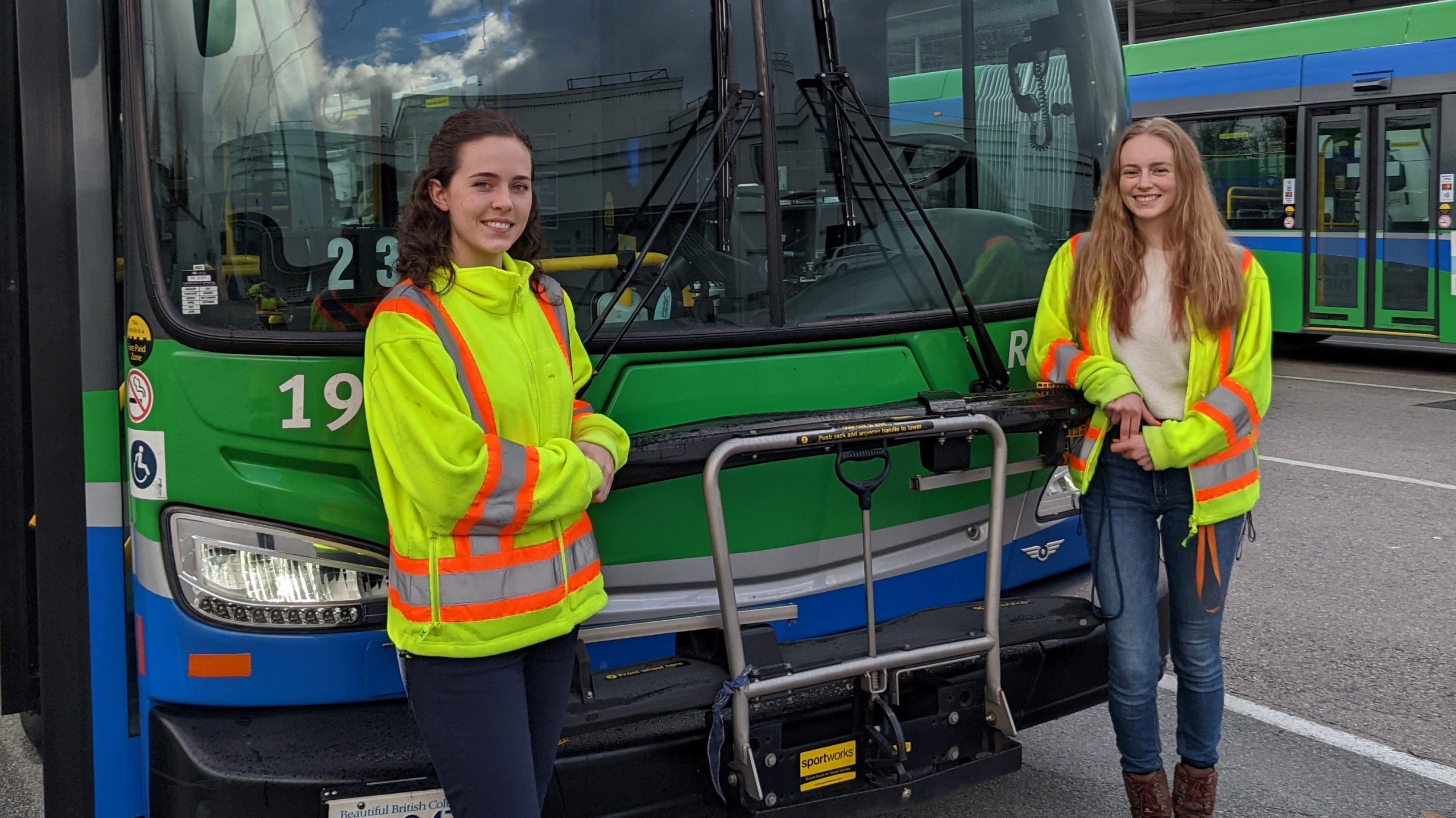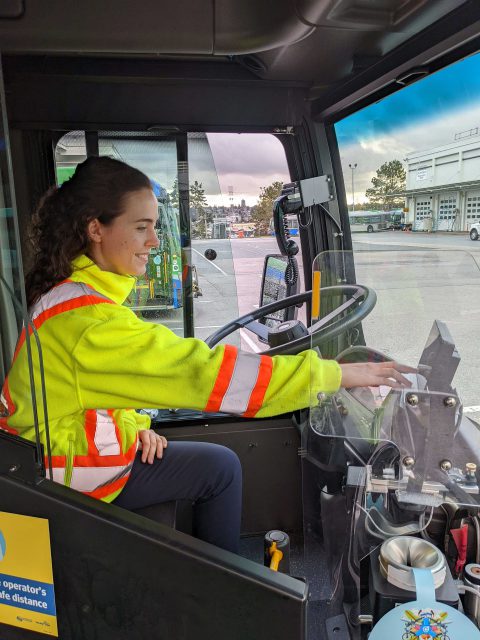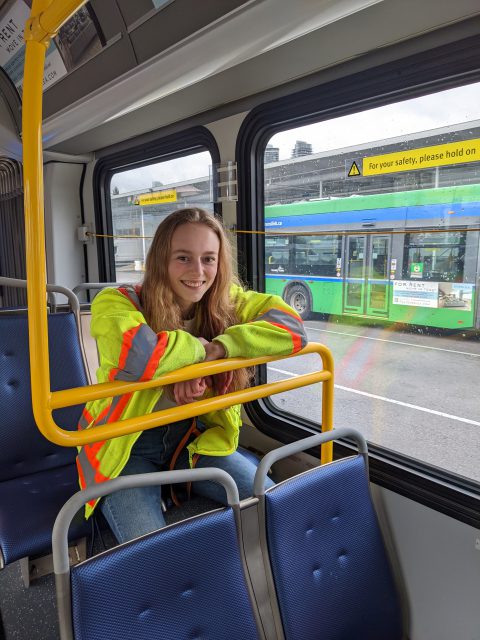How transit has been a live classroom for these engineering students
How transit has been a live classroom for these engineering students

To solve problems. That’s the job description for an engineer.
And both Layla Robson and Paula Themmen have strong ambitions to solve a huge problem that’s gripping us today: the climate crisis.
That’s why both took a keen interest in engineering. It was the only way to be a part of the solution. They are taking their first steps in fulfilling this goal by working at Coast Mountain Bus Company (CMBC) as co-operative education students in the maintenance engineering department.
Layla is a mechanical engineering student from the University of Victoria, while Paula is a sustainable energy engineering student from Simon Fraser University in Surrey.
Co-operative education, or co-op for short, is an experiential learning opportunity for post-secondary students where they enter the work force for a semester or two to apply the skills they’ve learned in school. Here at TransLink and its operating companies, our co-op students are doing work that matters.

Paula’s assisting with work on the battery-electric buses. The CMBC fleet currently consists of four battery-electric buses that are participating the pan-Canadian trial testing buses (New Flyer and Nova Bus) and chargers (ABB and Siemens) from different manufacturers — a first.
“We look at anything from the batteries to the charging systems,” says Paula. “We’re trying to learn as much about them now, so when we get more battery-electric buses, we can help make that a smooth transition.”
TransLink has purchased 15 new battery-electric buses set to arrive in the coming years that will allow us to fully electrify 100 22nd Street Station/Marpole Loop route. This is part of our aggressive approach to the Low Carbon Fleet strategy, which charts the path to a fully electric bus fleet by 2050.
This is all so gratifying and exciting for Paula hearing this news and being able to play a small part.
“I went into engineering because I wanted to work in renewable energy, specifically,” says Paula, who’s focussing on electrical engineering during her time at CMBC. “My objective is to work in helping to transition society away from fossil fuels. That’s one of my main goals in life, so I knew I had to go into engineering for that.”
It has also been an eye-opening experience for a lifelong transit rider like Paula. She was surprised to learn firsthand just how much work goes into delivering and operating a reliable transit system.
“Buses show up and they get to from point A to point B, so you don’t really think twice about it,” says Paula. “But I’ve learned there’s so much extra work behind the scenes that goes into making that a reliable system and having the bus show up every time. I think of all that communications equipment in the bus that I didn’t realize was there. It’s pretty interesting to learn about the inner workings of the electrical system of the bus.”
 For Layla, it’s been equally fulfilling working at CMBC where she’s creating technical drawings, including for the trolley wire de-icing truck and her very own part to help prevent water from entering an air intake on a bus.
For Layla, it’s been equally fulfilling working at CMBC where she’s creating technical drawings, including for the trolley wire de-icing truck and her very own part to help prevent water from entering an air intake on a bus.
“I’ve done a lot of parts designing,” says Layla, who’s been focussing on mechanical engineering at CMBC. “I go out with an engineer and we look at a problem. I assist with coming up with a solution. And if they need a part made, I help design it by making a 3D model.
“We test it out and if it looks like it will solve the problem, an actual part gets made and we’ll put it on a bus. This is cool and neat because it’s actually getting used on a bus that’s in service.”
That’s precisely what engineers do: they solve problems that haven’t been encountered before.
Traditionally, women are underrepresented in the science, technology, engineering and mathematics (STEM) fields at universities. According to Statistics Canada, 44 per cent of first-year university students aged 19 or less enrolled in STEM programs were women, while women made up more than 64 per cent of students in other fields.
“They’re just as interested as anyone else, so certainly what helps is having role models,” says Paula, who says in her program, it’s about a 40-60 split. “Like seeing an all-female astronaut spacewalk two years ago — that’s something that can inspire young girls for sure.
“The other thing is visiting schools and getting all kids interested in STEM. Show young girls that that they can do this too. I think young girls are interested. They just need that final push of ‘Yes, you are welcome and you’re wanted in this field.'”
That’s how Layla got into engineering. She was always interested in math, science, and physics in school. Layla also had a keen interest in figuring out how things worked, which made engineering a natural fit.
“I talked to teachers about it and they were like, ‘Yeah, this is a good option opportunity,'” she recalls. When Layla attended an engineering club fair at the University of British Columbia, her ambitions received another validation. Students demonstrated their “coolest” engineering projects, including rockets and racecars.
“I would encourage people to follow their passions regardless of past prejudices,” says Layla. “Don’t let it deter you. Even though engineering traditionally has been a male-dominated field, it doesn’t necessarily have to be any more.”
CMBC has been a highly successful live classroom decades since the early 1990s with many current leaders at CMBC receiving their start through co-op. Throughout the year, the Maintenance Engineering department always has two co-op students on payroll: one for mechanical engineering and another for electrical engineering.
Think you got what it takes? Keep an eye out for postings with your school and visit translink.ca/careers.






I’m so very proud of these girls!
Things have come a long way from when I went to university at UBC in 1968 I was asked what were my goals, I said structural engineering, the counsellor told me that women weren’t allowed in engineering at UBC… choose something in Arts she said.
Thanks for the info
Before diving into your AAFM exam preparations, it’s essential to understand the exam’s structure. Develop a detailed study plan that outlines your daily, weekly, and monthly study goals. Allocate more time to areas where you feel less confident. Consistency is crucial. Stick to your study plan, and don’t procrastinate. Regular revision is essential to retaining the information you’ve learned. https://www.certsboard.com/Online-AAFM-Access.html